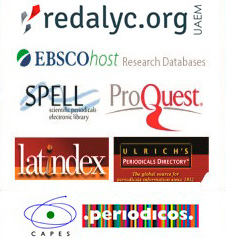MSDO / MDSO: A TECHNIQUE FOR REDUCING THE NUMBER OF CAUSAL CONDITIONS IN QUALITATIVE COMPARATIVE ANALYSIS
DOI:
https://doi.org/10.14210/alcance.v29n1(Jan/Abr).p2-19Keywords:
Crisp Set QCA. Comparative Qualitative Analysis. Causal Conditions Reduction.Abstract
Objective: this paper aims to exemplify and analyze each of the operational steps of the MSDO / MDSO technique in order to reduce the systemic complexity in the use of the csQCA method, with the support of the MDSO / MSDO web application. Methodological Design: Comparative analysis: more different cases with equal results and more similar cases with different results (MDSO / MSDO). An application of the technique was carried out to identify the causal conditions that explain the differences in innovative performance in 26 innovation networks in Brazil and Spain. Results From the twenty causal conditions analyzed, which were grouped into four categories (clusters) called Structural, Human, Financial and Organizational Resources, eight causal conditions explaining the difference in performance were identified. Methodological implications: Considering that one of the main problems in social research, including recent innovation studies, is the size of systemic complexity. The difficulty of reducing systemic complexity has been manifested repeatedly when researchers in the field of Administration and Innovation have used case analysis with binary data, called Crisp Set Comparative Qualitative Analyzes - csQCA. The MSDO / MDSO analysis (more different cases with equal results and more similar cases with different results) contributed to minimize this problem Originality: the technique has been less used in Brazil. The four stages of application of the technique are detailed demonstrated and analyzed.References
Berg-Schlosser, D. & De Meur, G. (2009). Comparative research design: case and variable selection. In: Rihoux, B. & Ragin, C. (Ed.) Configurational comparative methods. Qualitative comparative analysis (QCA) and related techniques (Chap. 2, pp. 19-32.). California, USA: Sage.
De Meur, G. (1996). La comparaison des systemes politiques: recherche des similarites et des differences. Revue Internationale de Politique Comparée, 3, 405-438.
De Meur, G. D. & Beumier, J. C. (2015). MDSO/MSDO (Version 1.1). Retrieved from http://www.jchr.be/01/v11.htm.
De Meur, G., Bursens, P., & Gottcheiner, A. (2006). MSDO/MDSO Revisited for Public Policy Analysis. In: Rihoux, B. & Grimm, H. (Ed.), Innovative Comparative Methods for Policy Analysis (pp. 67-94): Springer US.
De Meur, G. & Gottcheiner, A. (2009). The Logic and Assumptions of MDSO–MSDO Designs. In: Byrne, D. & Ragin, C. (Ed.). The sage handbook of case-based methods. (Cap, 11, pp. 208-211). California: Sage. DOI: https://dx.doi.org/10.4135/9781446249413.n12
Dias, A. T. (2013). Conjuntos parcimoniosos configuracionais estratégicos pelo método acq-análise comparativa qualitativa: um estudo do desempenho de firmas nos setores de indústria e serviço. Anais do Encontro de Estudos de Estratégia. Bento Gonçalves, Rio Grande do Sul, Brasil.
Dias, C. N. (2015). A influência das redes interorganizacionais e da complementaridade de recursos no desempenho da inovação: um estudo comparativo Brasil-Espanha no setor de pesquisa agropecuária. (Tese de Doutorado em Administração. Universidade de Brasília, Brasília, DF.
Dias, C. N.; Dias, M. F. P. & Martinéz-Fernández, M. T. (2018). Recursos competitivos para o desempenho inovador no setor de pesquisa agropecuária do brasil e espanha. EnANPAD 2018. Universidade Positivo, Curitiba, Paraná, Brasil.
Dias, M. F. P.; Pedrozo, E. A. (2015). Metodologia de Estudo de Caso com Múltiplas Unidades de Análise e Métodos Combinados para Estudo de Configurações. Iberoamerican Journal of Strategic Management (IJSM), 14, 23-39.
Lucidarme, S.; Cardon, G.; & Willem, A. (2016). A comparative study of health promotion networks: configurations of determinants for network effectiveness. Public management review, 18(8), 1163-1217.
Marx, A. & Dusa, A. (2011). Crisp-set qualitative comparative analysis (csQCA), contradictions and consistency benchmarks for model specification. Methodological innovations, 6(2), 103-148.
Mill, J. S. (1973) The collected works of John Stuart Mill. Volum VII - a system of logic, raciocinative, and inductive. (7, 388-406). London: Routledge and Kegan Paul.
Pattyn, V. (2015). Explaining variance in policy evaluation regularity. The case of the flemish public sector. Public Management Review, 17(10), p. 1475-1495.
Ragin, C. C. & Becker H. S. (1992). What is a case?: exploring the foundations of social inquiry, Cambridge: Cambridge University Press.
Ragin C.C., Sonnett J. (2005) Between Complexity and Parsimony: Limited Diversity, Counterfactual Cases, and Comparative Analysis. In: Kropp S., Minkenberg M. (Ed.) Vergleichen in der Politikwissenschaft. VS Verlag für Sozialwissenschaften. https://doi.org/10.1007/978-3-322-80441-9_9
Rihoux, B.; Ragin, C. C. (2009). Configurational comparative methods: Qualitative comparative analysis (QCA) and related techniques (pp. 19-32). California: Sage Publications
Schneider, C. Q. & Wagemann, C. (2012). Set-theoretic methods for the social sciences: a guide to qualitative comparative analysis, Cambridge: Cambridge University Press.
Downloads
Published
Issue
Section
License
Copyright (c) 2022 Revista Alcance

This work is licensed under a Creative Commons Attribution 4.0 International License.
In this statement of responsibility, I/we certify that I/we participated in the preparation of the attached article, thus making my/our responsibility for its content public. I/we declare that we have not omitted any links or financing agreements between me/us and entities and/or institutions that may have an interest in the publication of this article. I/we certify that the article is original and the work, either in total or in part, or any other work of my/our authorship with substantially similar content, has not been nor will be sent in any format (printed or electronic) to another periodical while its publication is being considered by Revista Alcance. In this consent form, the associated authors give permission to Revista Alcance, in the case of approval by its Editorial Board, to publish the attached article in electronic copy in a regular edition of the journal and to load it to the database.

